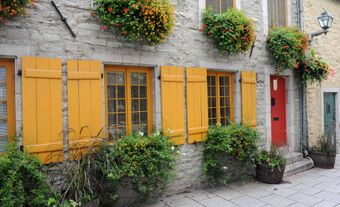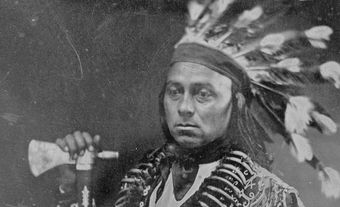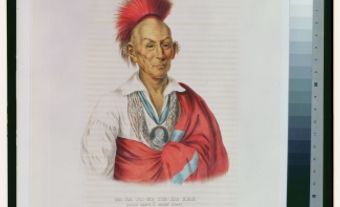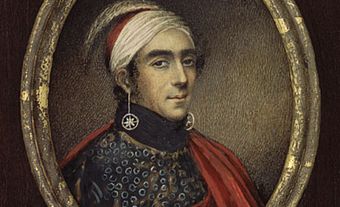Kondiaronk, Tionontati chief (born circa 1649; died 2 August 1701 in Montreal, QC). He has been known by several names throughout history, including Gaspar Soiaga, Souoias, Sastaretsi, and Le Rat (the Rat). Kondiaronk was one of the main brokers of the Great Peace of Montreal, signed in 1701. This peace agreement between the French and Haudenosaunee brought to an end almost a century of hostilities marked by atrocities on both sides. (See also Indigenous-French Relations in Canada.)

Kondiaronk’s Ethnic Identity
While Kondiaronk is often identified as a Wendat (Huron) chief, he was Tionontati. The Tionontati were referred to as “Petun Huron” during Kondiaronk’s lifetime, the 17th and early 18th centuries. The Wendat and Tionontati were closely related, part of a larger group of Iroquoian-speaking Indigenous people who lived in present-day Ontario.
Relations with Neighbouring First Nations
Around the time of Kondiaronk’s birth in 1649, war with the Haudenosaunee (Iroquois) had led the Tionontati to the Michilimackinac region (the islands in and the land around the Straights of Mackinac, which separates Lake Huron from Lake Michigan.) This region was already home to several Algonquian peoples. Though the Tionontati were friendly and traded with the Algonquians, they were culturally and linguistically distinct. These circumstances likely played an important role in developing Kondiaronk’s diplomatic skills.
Relations with the French
Kondiaronk first came to the attention of the French in 1682. He argued that, as the dominant European power in the area, the French needed to protect the Indigenous peoples of the Michilimackinac region against the possibility of attacks from the Haudenosaunee. Governor of New France, Louis de Buade, Comte de Frontenac, (who served as governor from 1672–82 and again from 1689-98) ultimately declined to provide Kondiaronk with the protection he requested. Haudenosaunee raids against Wendat and Tionontati communities continued unabated.
Jacques-Renéde Brisay, Marquis de Denonville, who served as Governor of New France from 1685–89, invaded Onöndowa’ga (Seneca) territory in 1687. (The Onöndowa’ga are one of six First Nations that make up the Haudenosaunee Confederacy.) Kondiaronk secured a pledge from him that the Haudenosaunee would be destroyed. However, Kondiaronk believed that his people were still vulnerable to Haudenosaunee attacks. Therefore, he raised a war party and set out in 1688 to strike a defensive blow.
Upon his arrival at Fort Frontenac (now Kingston, Ontario), Kondiaronk was surprised to discover that Denonville was, in fact, negotiating a peace treaty with the Haudenosaunee, whose diplomats were due to pass through en route to Montreal. Instead of returning home, as he was advised, Kondiaronk crossed Lake Ontario and intercepted the Onondaga delegation. (The Onondaga are another Haudenosaunee First Nation.) Kondiaronk and his warriors attacked the delegation, killing its chief, wounding several members of the party and taking the rest as prisoners.
In this situation, Kondiaronk displayed incredible cunning. Knowing that his people had been betrayed by the French, he told the captive Onondaga that Denonville had betrayed them. When the Onondaga ambassador, Teganissorens, stated that they were on a diplomatic mission of peace, Kondiaronk insinuated that he was unaware of this and that he had been tricked by the French into attacking the Onondaga. Kondiaronk then released the Onondaga prisoners and offered them a present of firearms, indicating that he could never forgive the French for their treachery and that he would find it acceptable for the Onondaga to take their vengeance. The ruse worked, as the Onondaga offered Kondiaronk a separate peace. The parties separated to return to their homes, and the Onondaga offered him an adopted Shawnee to replace one of his men who had been killed in battle, as was the tradition among Indigenous people of the era. Kondiaronk and his band crossed the lake once more and, as he passed by Fort Frontenac, called out to its commander, “I have just killed the peace; we shall see how Onontio (the Governor of New France) will get out of this business.”
Upon returning to Michilimackinac, Kondiaronk presented the Shawnee to the French commander as a Haudenosaunee captive, who, in turn, decided to execute him. Kondiaronk sent for a Onöndowa’ga slave to witness the execution but told the slave the truth of the matter and freed him on the condition that he would return to his people to speak of the French treachery and disregard for Indigenous custom. Kondiaronk’s master strategy had worked. He had brilliantly sabotaged the attempt by the French to secure peace with the Haudenosaunee and had done so while securing his own peace, all without alerting the French to his actions.

Role in the Great Peace of Montreal
From 1689 onward, Kondiaronk was involved in many political intrigues. He plotted with the Haudenosaunee against the Odawa, travelled to Montreal in defiance of the French and obliterated the possibility of a Wendat-Haudenosaunee-English alliance. When he felt that such an alliance threatened his power, he killed 55 Haudenosaunee in a canoe ambush on Lake Erie in 1697. Doing so helped re-establish his prominence and further secured the Wendat of Michilimackinac as deserving of French support.
The Treaty of Ryswick, signed in 1697, ended the war between the French and English in Europe and this, in turn, led to the governors of New York and New France agreeing to suspend their hostilities. It also meant that there were renewed efforts to broker a French-Haudenosaunee peace.
In 1700, Governor of New France Louis-Hector de Callière convened a meeting in Montreal to settle an armistice in advance of the ultimate peace settlement achieved the following year.
The peace congress began on 21 July 1701 when historian Claude-Charles Le Roy de La Potherie, who was also the primary source of the proceedings, went to the mission at Kahnawake to receive the Haudenosaunee representatives. A flotilla of canoes carrying the Haudenosaunee diplomatic missions of Cayuga, Onondaga, and Onyota’a:ka (Oneida) arrived, with representatives of the Kanienʼkehá꞉ka (Mohawk) arriving later. They undertook various ceremonies and conferenced together in preparation for their meeting the next day with Governor de Callière.
The diplomatic effort involved various rituals and ceremonies. Reciprocity was a major feature, as was feasting, exchanging prisoners, distributing presents, making prolonged speeches and smoking. On 22 July 1701, 200 canoes brought approximately 700 Indigenous allies of the French to Montreal, including emissaries and diplomats from the Chippewa, Odawa, Potawatomi, Wendat, Miami, Winnebago, Menominee, Sauk, Fox and Mascouten nations. Negotiations were well underway by 25 July 1701.
Kondiaronk had become quite ill during the negotiations from an epidemic that was sweeping Montreal. By the beginning of deliberations on 1 August 1701, he was so sick that he could not stand. He was brought an armchair and offered wine and other fortifying drinks to support his spirit, as all those who had convened wanted desperately to hear his wise council. Kondiaronk rallied and spoke for two hours, recounting his efforts at protecting his people, recovering prisoners and convincing First Nations delegates to come to Montreal. His speech touched all who heard it. Kondiaronk was carried in his armchair to the Hôtel-Dieu of Montreal, where he passed away just a few hours later.
Kondiaronk was granted a grand funeral by Governor de Callière. He was buried in Notre-Dame Church. The day after his funeral, the Great Peace of Montreal was signed, ending the Beaver Wars that had raged for almost the entirety of the 17th century.
Recognition
Kondiaronk is recognized as a National Historic Person by the Historic Sites and Monuments Board of Canada, which is an agency of Parks Canada. (See also National Historic Sites in Canada.) This recognition is appropriately located at Place de la Grande-Paix-de-Montréal, a public square in the Old Montreal section of Montreal, Quebec. At this site, Kondiaronk is recognized for the pivotal role he played in “facilitating negotiations which culminated in the Treaty of 1701.”
The belvedere atop Montreal’s Mount Royal is also named in honour of Kondiaronk. A plaque unveiled in 1997 explains the dedication honouring Kondiaronk for his role in securing the Great Peace of Montreal in 1701, as well as his skills as an orator, politician and military strategist.

 Share on Facebook
Share on Facebook Share on X
Share on X Share by Email
Share by Email Share on Google Classroom
Share on Google Classroom





.jpg)







